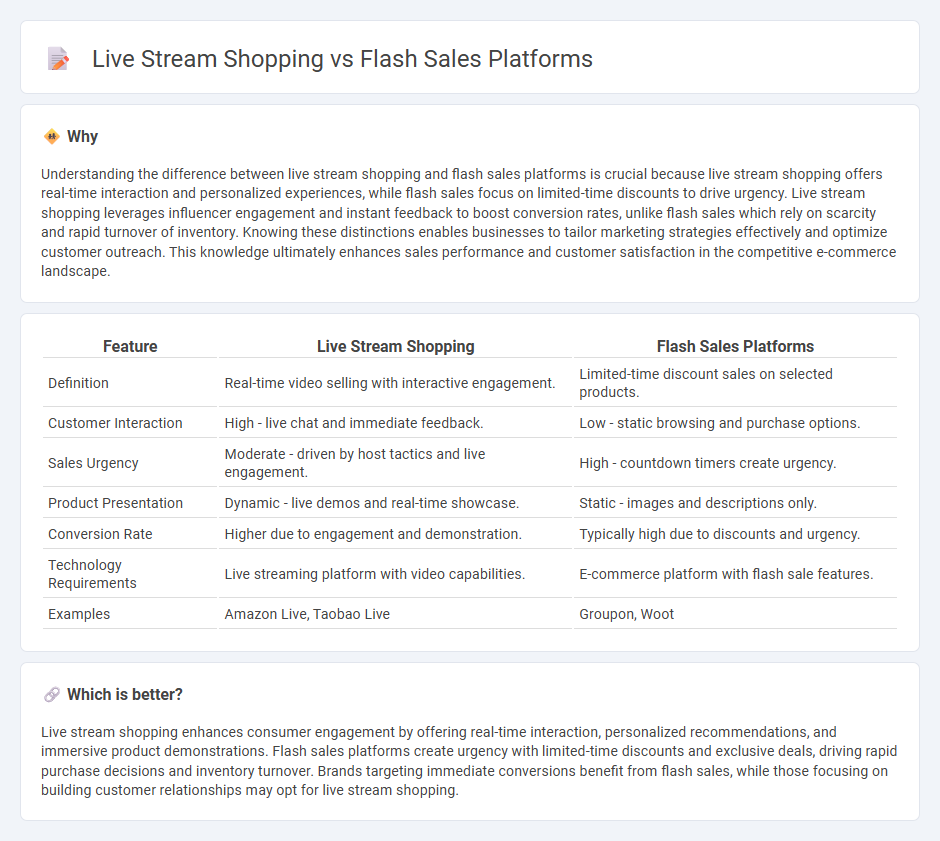
Live stream shopping platforms transform real-time engagement into instant purchases by combining entertainment with e-commerce, driving higher conversion rates through interactive product demonstrations. Flash sales platforms create urgency with limited-time deals, leveraging scarcity to boost rapid sales and attract bargain hunters. Explore how these dynamic commerce models revolutionize consumer behavior and sales strategies.
Why it is important
Understanding the difference between live stream shopping and flash sales platforms is crucial because live stream shopping offers real-time interaction and personalized experiences, while flash sales focus on limited-time discounts to drive urgency. Live stream shopping leverages influencer engagement and instant feedback to boost conversion rates, unlike flash sales which rely on scarcity and rapid turnover of inventory. Knowing these distinctions enables businesses to tailor marketing strategies effectively and optimize customer outreach. This knowledge ultimately enhances sales performance and customer satisfaction in the competitive e-commerce landscape.
Comparison Table
| Feature | Live Stream Shopping | Flash Sales Platforms |
|---|---|---|
| Definition | Real-time video selling with interactive engagement. | Limited-time discount sales on selected products. |
| Customer Interaction | High - live chat and immediate feedback. | Low - static browsing and purchase options. |
| Sales Urgency | Moderate - driven by host tactics and live engagement. | High - countdown timers create urgency. |
| Product Presentation | Dynamic - live demos and real-time showcase. | Static - images and descriptions only. |
| Conversion Rate | Higher due to engagement and demonstration. | Typically high due to discounts and urgency. |
| Technology Requirements | Live streaming platform with video capabilities. | E-commerce platform with flash sale features. |
| Examples | Amazon Live, Taobao Live | Groupon, Woot |
Which is better?
Live stream shopping enhances consumer engagement by offering real-time interaction, personalized recommendations, and immersive product demonstrations. Flash sales platforms create urgency with limited-time discounts and exclusive deals, driving rapid purchase decisions and inventory turnover. Brands targeting immediate conversions benefit from flash sales, while those focusing on building customer relationships may opt for live stream shopping.
Connection
Live stream shopping leverages real-time engagement to create urgency and boost sales, seamlessly integrating with flash sales platforms that offer limited-time discounts. Both models harness instant purchasing triggers and social proof to maximize conversion rates and drive rapid inventory turnover. This synergy enhances consumer excitement, blending interactive content with time-sensitive deals to elevate e-commerce performance.
Key Terms
Real-time engagement
Flash sales platforms offer limited-time discounts that create urgency and drive quick purchases, while live stream shopping combines real-time interaction with product demonstrations to boost consumer engagement. Live streaming enables brands to respond instantly to viewer questions, enhancing trust and increasing conversion rates through dynamic presentations. Explore how real-time engagement strategies differ between these models to optimize your ecommerce approach.
Limited-time offers
Flash sales platforms specialize in limited-time offers by providing steep discounts on select products within a short window, creating urgency and driving quick consumer purchases. Live stream shopping leverages real-time engagement with hosts showcasing products, often featuring exclusive deals or flash sales embedded in the broadcast to encourage spontaneous buying. Discover how integrating flash sales with live streaming can amplify limited-time offer effectiveness and boost sales conversion rates.
Influencer-driven sales
Flash sales platforms leverage limited-time discounts to drive rapid purchases, capitalizing on urgency and exclusive deals. Live stream shopping enhances influencer-driven sales by combining real-time interaction and authentic product demonstrations, fostering trust and immediate buying decisions. Explore how brands optimize these channels to amplify influencer impact and boost e-commerce revenue.
Source and External Links
What Is A Flash Sale? How to Run One and Examples (2025) - Shopify - A flash sale is a short-term discount promotion that creates urgency and scarcity, successfully increasing revenue and conversion rates when combined with targeted marketing like social media and SMS, exemplified by brands like MadebySUNDAY.
What are flash sales? - BigCommerce - Flash sales offer time-limited discounts on limited stock to trigger impulse buying, and are effective for quickly moving excess or out-of-season inventory, with some businesses like Zulily fully built on this model.
Flash Sales Explained: Strategies, Benefits, and Best Practices for ... - Flash sales can be enhanced through personalization and AI techniques such as dynamic pricing, behavioral targeting, and predictive analytics to optimize inventory and deliver tailored customer experiences for better results.
 dowidth.com
dowidth.com